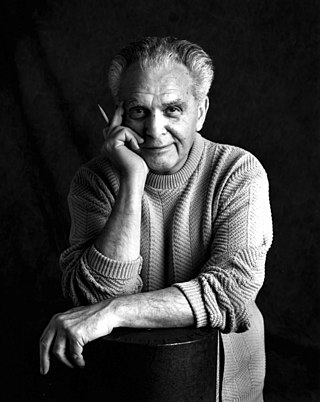
Jack Kirby was an American comic book artist, widely regarded as one of the medium's major innovators and one of its most prolific and influential creators. He grew up in New York City and learned to draw cartoon figures by tracing characters from comic strips and editorial cartoons. He entered the nascent comics industry in the 1930s, drawing various comics features under different pen names, including Jack Curtiss, before ultimately settling on Jack Kirby. In 1940, he and writer-editor Joe Simon created the highly successful superhero character Captain America for Timely Comics, predecessor of Marvel Comics. During the 1940s, Kirby regularly teamed with Simon, creating numerous characters for that company and for National Comics Publications, later to become DC Comics.

"Fourth World" was a metaseries of connected comic book titles written and drawn by Jack Kirby and published by DC Comics from 1970 to 1973. Although they were not marketed under this title until the August–September 1971 issues of New Gods and Forever People, the terms Fourth World and Jack Kirby's Fourth World have gained usage in the years since. Kirby created the Fourth World concept in the 1970s. The series is a science-fiction based mythology that revolves around ancient space deities known as the New Gods. The New Gods are similar to the gods of Earth lore.

The Sandman is a comic book written by Neil Gaiman and published by DC Comics. Its artists include Sam Kieth, Mike Dringenberg, Jill Thompson, Shawn McManus, Marc Hempel, Bryan Talbot, and Michael Zulli, with lettering by Todd Klein and covers by Dave McKean. The original series ran for 75 issues from January 1989 to March 1996. Beginning with issue No. 47, it was placed under DC's Vertigo imprint, and following Vertigo's retirement in 2020, reprints have been published under DC's Black Label imprint.

Vertigo Comics was an imprint of American comic book publisher DC Comics started by editor Karen Berger in 1993. Vertigo's purpose was to publish comics with adult content, such as nudity, drug use, profanity, and graphic violence, that did not fit the restrictions of DC's main line, thus allowing more creative freedom. Its titles consisted of company-owned comics set in the DC Universe, such as The Sandman and Hellblazer, and creator-owned works, such as Preacher, Y: The Last Man and Fables.

Grant Morrison MBE is a Scottish comic book writer, screenwriter, and producer. Their work is known for its nonlinear narratives, humanist philosophy and countercultural leanings. Morrison has written extensively for the American comic book publisher DC Comics, penning lengthy runs on Animal Man, Doom Patrol, JLA, Action Comics, and The Green Lantern as well as the graphic novels Arkham Asylum, JLA: Earth 2, and Wonder Woman: Earth One, the meta-series Seven Soldiers and The Multiversity, the mini-series DC One Million and Final Crisis, both of which served as centrepieces for the eponymous company-wide crossover storylines, and the maxi-series All-Star Superman. Morrison's best known DC work is the seven-year Batman storyline which started in the Batman ongoing series and continued through Final Crisis, Batman and Robin, Batman: The Return of Bruce Wayne and two volumes of Batman Incorporated. They also co-created the DC character Damian Wayne.

The Invisibles is a comic book series published by the Vertigo imprint of DC Comics from 1994 to 2000. It was created and scripted by Scottish writer Grant Morrison, and drawn by various artists throughout its publication.
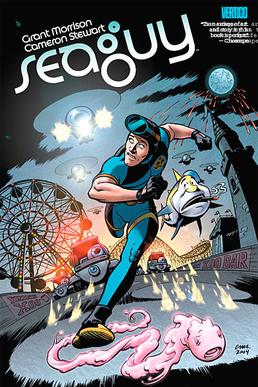
Seaguy is a three-volume comic book miniseries written by Grant Morrison with art by Cameron Stewart and published by the Vertigo imprint of DC Comics. The first volume of Seaguy was released in three issues beginning on May 19, 2004. The second volume, Slaves of Mickey Eye, was released in three issues beginning on April 1, 2009. The third and final volume, Seaguy Eternal, is yet to be published.
Strange Tales is a Marvel Comics anthology series. The title was revived in different forms on multiple occasions. Doctor Strange and Nick Fury, Agent of S.H.I.E.L.D. made their debuts in Strange Tales. It was a showcase for the science fiction/suspense stories of artists Jack Kirby and Steve Ditko, and for the groundbreaking work of writer-artist Jim Steranko. Two previous, unrelated magazines also bore that title.

The Filth is a comic book limited series, written by Grant Morrison and drawn by Chris Weston and Gary Erskine. It was published by the Vertigo imprint of American company DC Comics in 2002.
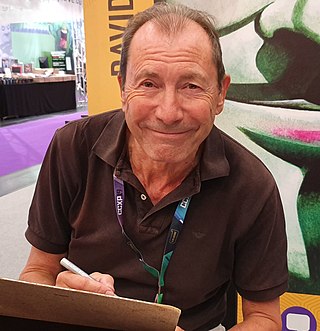
David Lloyd is an English comics artist best known as the illustrator of the story V for Vendetta, written by Alan Moore, and the designer of its anarchist protagonist V and the modern Guy Fawkes/V mask, the latter going on to become a symbol of protest.
Philip J. Bond is a British comic book artist, who first came to prominence in the late 1980s on Deadline magazine, and later through a number of collaborations with British writers for the DC Comics imprint Vertigo.
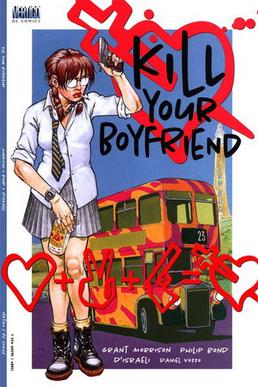
Kill Your Boyfriend is the title of a comic book one-shot written by Grant Morrison and drawn by Philip Bond and D'Israeli for DC Comics Vertigo imprint in June 1995.

Crestwood Publications, also known as Feature Publications, was a magazine publisher that also published comic books from the 1940s through the 1960s. Its title Prize Comics contained what is considered the first ongoing horror comic-book feature, Dick Briefer's "Frankenstein". Crestwood is best known for its Prize Group imprint, published in the late 1940s to mid-1950s through packagers Joe Simon and Jack Kirby, who created such historically prominent titles as the horror comic Black Magic, the creator-owned superhero satire Fighting American, and the first romance comic title, Young Romance.

Jack of Fables is a spin-off comic book series of Fables written by Bill Willingham and Lilah Sturges and published by DC Comics' Vertigo imprint. The story focuses on the adventures of Jack Horner, a supporting character in the main series, that takes place after his exile from Fabletown in the story-arc Jack Be Nimble. The idea for the spin-off comic came after editor Shelly Bond suggested to put Jack in a separate comic when Willingham planned to write him out of the series.

Weird Mystery Tales was a mystery horror comics anthology published by DC Comics from July–August 1972 to November 1975.
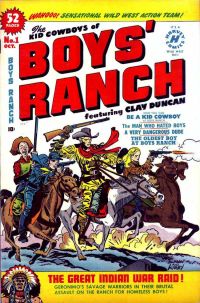
Boys' Ranch is a six-issue American comic book series created by the veteran writer-artist team of Joe Simon and Jack Kirby for Harvey Comics in 1950. A Western in the then-prevalent "kid gang" vein popularized by such film series as "Our Gang" and "The Dead End Kids", the series starred three adolescents—Dandy, Wabash, and Angel—who operate a ranch that was bequeathed to them, under the adult supervision of frontiersman Clay Duncan. Supporting characters included Palomino Sue, Wee Willie Weehawken, citizens of the town Four Massacres, and various Native Americans, including a fictional version of the real-life Geronimo.

Joe the Barbarian is an eight-issue comic book limited series written by Grant Morrison and drawn by Sean Murphy. It was published in 2010-2011 by Vertigo Comics.

Shade, the Changing Man is an American superhero comic book featuring the character of the same name. The series was written by Peter Milligan and published by DC Comics; it lasted for 70 issues, from July 1990 to April 1996. The final 37 issues were published under the company's Vertigo imprint for mature readers. Shade, the Changing Man chronicles the adventures of Rac Shade, an alien from the planet Meta who becomes stuck in the body of Troy Grenzer, a convicted serial killer. The series' long-term story arc focuses on the relationship between Shade and Kathy George, a girl whose parents were killed by Grenzer.

"Nick Fury, Agent of S.H.I.E.L.D." was a feature in the comics anthology Strange Tales which began in 1965 and lasted until 1968. It introduced the fictional spy agency S.H.I.E.L.D. into the Marvel Comics world and reintroduced the character of Nick Fury as an older character from his concurrently-running series Sgt. Fury and his Howling Commandos, which was a series set during World War II. The feature replaced the previously running Human Torch feature in the book and ran alongside the Doctor Strange feature. After the feature ended, a comic book series was published which has had several volumes as well as a comic strip. The feature was originally created by the duo of Stan Lee and Jack Kirby who also created the original Sgt. Fury series but it was later taken over by artist and writer Jim Steranko. The feature was often censored by the Comics Code Authority due to Jim Steranko's provocative art; this art helped change the landscape of comics which Steranko continued with in the 1968 ongoing series. Much of Nick Fury's supporting cast originated in the feature and many of the devices used by these characters were often used in other comics published by Marvel.
















